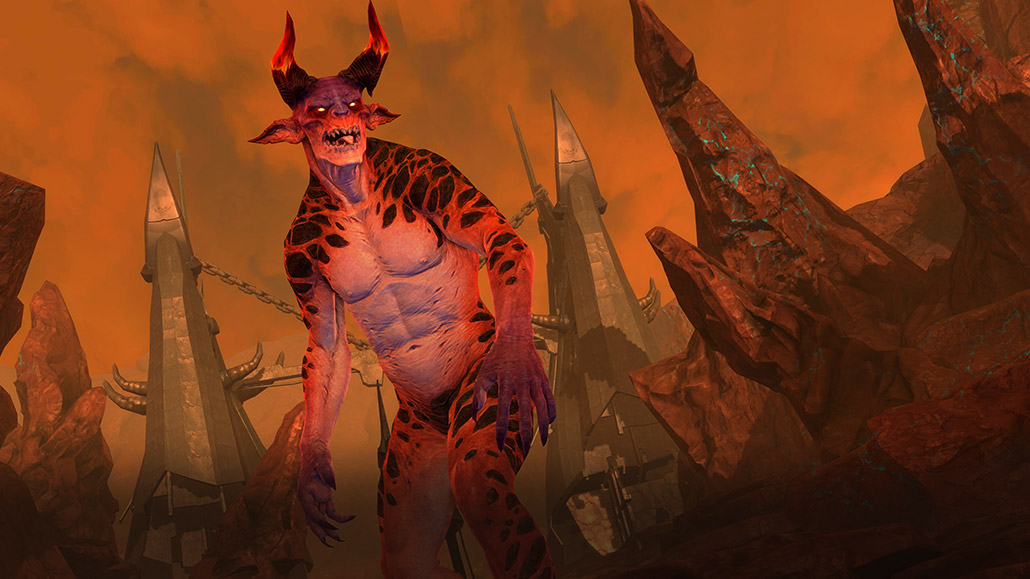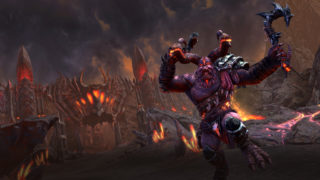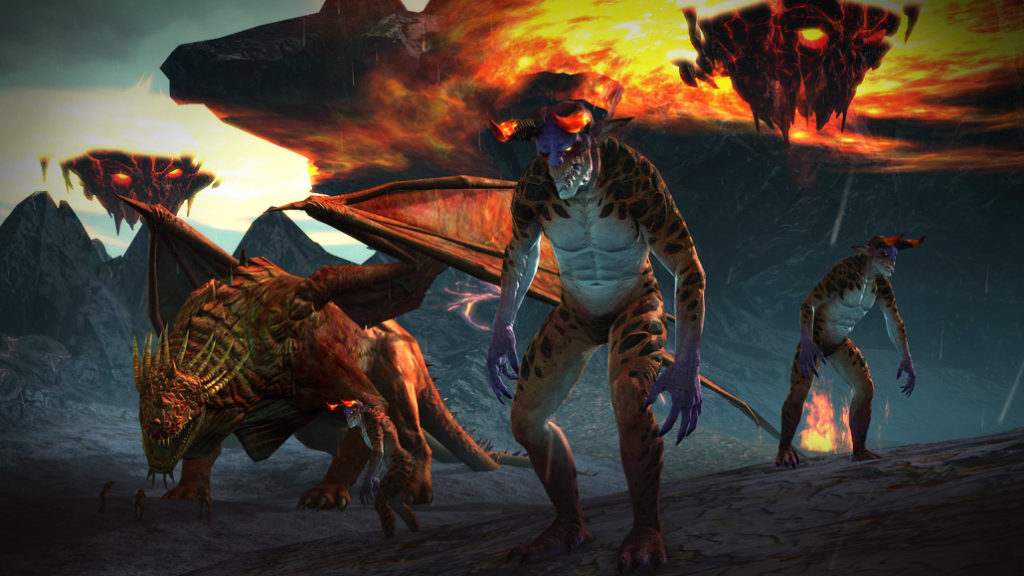Rift is a fantasy MMO (Massively Multiplayer Online game) that first launched in 2011 and it is still going strong, thanks in large part to its transition to being a free-to-play game in 2013. It’s a game that seems to only get better with age. The game will soon launch a paid expansion called Starfall Prophecy, which recently started its open beta and will launch on November 16. It includes a host of new content—with a particular focus on the dynamic events Rift is known for.
To learn what it takes to keep an MMO going strong for so many years, [a]listdaily spoke to Trion Worlds CEO, Scott Hartsman, and Rift’s senior design director, Simon Ffinch. The two talk about how players are taking to paying for an expansion to a free-to-play game, and where MMOs fit in today’s world full of online games.
How has Rift changed since it first released in 2011?
[Hartsman]: Trion, in a very realistic way, is the house that Rift built. Rift was our first tentpole—it’s always going to be our spiritual core. I was originally executive producer on the game, so it has always got a special place in my heart. Over time, it has grown tremendously through paid expansions as well as large free updates. The team has created more new world space, new Rift Events, and more new types of dynamic content over the years than I’ve ever seen in another MMO.
[Ffinch]: It’s more than quadruple its original size. I’ve been working on and playing Rift for eight years now, and I still absolutely love it. Echoing what Scott said, it has a very special place in everyone’s hearts here.
How did going free-to-play impact the player base?
[Hartsman]: Free-to-play has been a fantastic way to reignite interest in Rift. We made the transition in mid-2013 and we had a blast of new users that rivaled that of what we got at launch. Without intending to, it was essentially a relaunch of the game. It’s been a fantastic way to continue bringing in new users.
[Ffinch]: It is the ultimate “try before you buy” kind of experience. You can play so much of Rift and never have to pay us anything, but if you find that you really like it and you want to stay, then there’s plenty of opportunities to augment your look and various other things. But all of the content that’s currently in the game today, you can play for free.
How have you managed to sustain a strong player base for so many years?
[Hartsman]: One of the things that Rift hangs its hat on is dynamic content. Rift was one of the first, and is still one of the best at zone-wide and worldwide events and localized dynamic content. If you are going to keep these games alive and healthy into the five, ten and fifteen-year range like the first MMOs, [then] it’s a pretty big investment on our side to make sure the games are competitive—you have to be willing to make it.
Can you describe what the Starfall Prophecy expansion is about?
[Ffinch]: In a nutshell, there’s a big comet that’s been traveling through space and the planes, and it has gathered all sorts of bits and pieces to itself. That’s where the players are going to go: essentially five new zones. They’re absolutely gorgeous; I think our artists managed to notch up the look of Rift.
So, five gorgeous new zones, more new systems than you can shake a stick at, [along with] tons of content and thousands of hours of gameplay for players to sink their teeth into. In fact, at a recent show, people were looking at Starfall Prophecy and asked, “hey, when is this game coming out?” They were looking at it, and it looks competitive with games that are coming out today even though it’s six years old. We were pretty proud of that.
Why have a paid expansion for a free-to-play game, and how are fans taking to it?
[Hartsman]: In general, I think very well. In order to have a super-successful free-to-play game, a lot of the time what you’ll see are features that you might not get access to without extended grinding. Or you’ll see a lot of consumables that need to be paid for in order to experience the game in an optimal way. Rift doesn’t really have elements like that. While free-to-play was a natural fit for some of the elements, it wasn’t for others. For example, the last expansion we did was a free expansion, but obviously, there were things that we charged for. What we essentially did was give away all of the real estate and the things that we charged for were things like new equipment slots or new storage space for gear.
What we found was that, even though it was financially successful, it wasn’t something that the core players were interested in. We found ourselves at odds with our own customer base a lot more than we liked—we don’t ever want to be at odds with our customers. So, what we thought was, “if you guys are interested in a flat and even playing field for an expansion, without us having to do things like sell you access to new equipment slots, the let’s just make it a flat buy to play again.”
The reaction has been generally very positive, because it’s a very easy-to-digest thing of buying the expansion and getting the standard set of things they’re used to with an expansion as opposed to us potentially creating negative surprises. We were trying to make this about positive sentiment as much as possible.
[Ffinch]: The way I look at it is that it’s a continuation of our philosophy with Rift since day one, which is listening and collaborating with our players. We’ve done many things in conjunction and in reaction to what they were saying. This is just another thing that we heard after we released our last expansion, and we’re trying to address their concerns. We will continue to listen to them, and so far—as Scott said—things seem very positive, and we haven’t even launched the expansion yet.
[Hartsman]: I’m a big believer in that business models can’t be a religion, like many companies take them as. You can tell if a business model is good when it fits the team, the product and the audience. For this game, this team and this audience at this time, this is definitely the right call.

Are there concerns that a premium update will divide the audience?
[Hartsman]: That is always a concern, and it’s something that we’re going to keep an eye on. We can see the data of what adoption looks like every day and because of our platform, we can do things like gifting or create other incentives. [Or] we can add other features to make sure players can always play together. One of the great things about Rift’s dynamic content layer is that it’s global to the entire game. So, there will always be ways to play with your friends.
With so many multiplayer games available now, including MOBAs and online role-playing games such as The Division, what space do MMOs occupy in the gaming space now?
[Hartsman]: I think what you’re seeing in a lot of games is that a lot of people are noticing changes and you see that reflected in what they’re implementing in their games. When you look across culturally, what you find is that back when MMOs were first born, people used them as ways to make friends online. They were ways to connect with people across the world, and you’re banding together and doing things for long periods of time, filling a real social need.
Today, we’re in the era where the entire world’s population is online. Everyone already has contact with essentially everyone they’ve ever met through things like Facebook, LinkedIn, Twitter and so on. So, the role of MMOs have had to adapt over time. The way it has adapted is by having more types of drop-in/drop-out content. In order to stay relevant, the content needs to remain increasingly accessible and in consumable size chunks that people are interested in investing in.
 [Ffinch]: I think MMOs have always, even in the old days, been about providing a wide variety of experiences. So, you have something quick for somebody who may only have half an hour to play versus people who want a three or four-hour raid. You have to make sure there’s something for both groups of players.
[Ffinch]: I think MMOs have always, even in the old days, been about providing a wide variety of experiences. So, you have something quick for somebody who may only have half an hour to play versus people who want a three or four-hour raid. You have to make sure there’s something for both groups of players.
[Hartsman]: One of things that’s true about the state of MMOs today is that despite the fact that a lot of us talk about short-play content, what we still find—whether it’s Destiny, World of Warcraft, Final Fantasy or one of our six games—is that there are people that want to play these games for extended periods of time. They just want to be in more control over how that time is spent. It’s up to all of us as developers to find ways to give it to them.
How is Rift reaching out to new players in the millennial generation?
[Hartsman]: We actually don’t target young audiences for any of our games. Even for games like Trove, the largest groups of people that we see tend to be in the 17-35 age group. Some of the more classic games have growing audiences of older gamers. What we’re seeing is that we have this generation of people that grew up with games and they’re not stopping gaming when they get older. When we look across games in general, the largest and most rapidly growing groups of gamers are females 50 and over. As the world’s populace gets online, they turn into gamers. I think you’re artificially limiting yourself if you’re solely trying to create games for the kids.
When you end up with too many games that are aiming for the kids, you end up with a glut of certain game types. I think MOBAs are an excellent example to use, where too many different games all went after what they thought was a salient audience, and suddenly you end up with three or four survivors with twenty shutting down. I think you have to be careful to not always try to chase what’s going to be cool next, because you’re going to make yourself a flash in the pan. We’ve proven that our games and our types of games have staying power well beyond what most people would expect.

